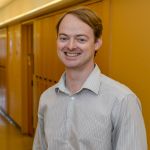
Sean Megason
Harvard Medical School, Department of Systems Biology
Armenise Building, Room 539
200 Longwood Ave.
Boston, MA 02115
Tel: 617-432-7441
Email: sean_megason@hms.harvard.edu
Website:
https://sysbio.med.harvard.edu/sean-megason
Lab Size: Between 10 and 15
Summary
The Megason lab is interested in how the program contained in the genome is executed during development to turn an egg into an embryo. We use confocal/2-photon imaging of living, transgenic zebrafish embryos to watch biological circuits function in vivo and use these data in cell-based, quantitative modeling.
The Megason Lab has pioneered the use of in toto imaging for revealing the origin of biological form. With the completion of the genome projects, it is now clear that animals have very similar sets of genes. Yet, as is clear to any toddler at a zoo, the diversity of biological form, from the stripes of a zebra to the trunk of an elephant, that can be generated with this same toolbox is astounding. How can the linear sequence of information encoded by the A’s, G’s, C,’s and T’s in the genome be converted into elaborate tissues of the precise size, shape, and organization required for their function?
Biological form is generated during development as the seemingly simple egg elaborates into the morphologically complex embryo. I believe that the mechanistic principles that turn an egg into an embryo span many levels from molecules to cells to whole tissues. Developmental biologists have been quite successful in recent decades in determining molecular level mechanisms, such as the genes governing cell fate decisions, but have made comparatively little progress in other long standing questions in development such as patterning, morphogenesis, and size control. There are two reasons for this failure. One is that these questions cannot be answered using the reductionist logic of one gene, one function. Understanding these phenomena will require a more systems biological approach. The other reason progress has been slow is because the key mechanisms regulating these phenomena do not only occur at the molecular level but also occur at higher levels such as cell dynamics and tissue mechanics.
We have developed a technological approach called in toto imaging which is capable of capturing biological information across all these scales—molecular, cellular, tissue, and whole embryo—in a dynamic fashion. For in toto imaging, we use transgenic zebrafish embryos that are labeled with multiple colors of fluorescent proteins; high-resolution, timelapse confocal/2-photon microscopy is performed to generate image sets containing 100,000 images; and custom developed software called GoFigure is used to track all the cells and quantify molecular, cellular, and tissue level data. We are using in toto imaging in combination with mathematical and computational modeling to elucidate the multiscale principles controlling patterning, morphogenesis, and size control in the zebrafish inner ear and spinal cord.
Publications
Xiong F, Megason SG. (2015). "Abstracting the principles of development using imaging and modeling", Integrative Biology, 7, 633 - 642
Hiscock TW, Megason SG. (2015). "Mathematically guided approaches to distinguish models of periodic patterning", Development 142, 409-419.
Xiong F, Ma W, Hiscock TW, Mosaliganti KR, Tentner AR, Brakke KA, Rannou N, Gelas A, Souhait, Swinburne IA, Obholzer ND, Megason SG. (2014). "Interplay of cell shape and division orientation promotes robust morphogenesis of developing epithelia." Cell, 159(2):415-427.
Xiong F, Tentner AR, Huang P, Gelas A, Mosaliganti KR, Souhait L, Rannou R, Swinburne IA, Obholzer ND, Cowgill PD, Schier AF, Megason SG (2013). "Specified Neural Progenitors Sort to Form Sharp Domains after Noisy Shh Signaling" , Cell, 153(3):550-561.
Mosaliganti KR, Noche RR, Xiong F, Swinburne IA, Megason SG. (2012). "ACME: Automated Cell Morphology Extractor for Comprehensive Reconstruction of Cell Membranes". PLoS Comput Biol 8(12):e1002780
